-
Car Reviews
- Car News
-
Car Comparisons
Latest comparisons
- Chasing Deals
The electric 500e is a huge landmark in Abarth’s storied history and a fresh spin in lightweight EV fun. But it falls short in a few key areas despite its obvious charm
Let’s not beat bushy things. The landmark electric Abarth, the 500e, is tremendously charming, a fun-filled backroad stormer and a very handy urban runabout. And yet the Italian newcomer is compromised in practicality and modest in power, performance and range credentials by contemporary EV measures.
Starting at just under $60K list it, enters the EV fray from left field with aims of swoon buyers away from the likes of the hugely popular and more moderne Tesla Model 3 and a more potent and vastly quicker dual-motor MG4 X-Power, to name just two of many electric competitors wanting for roughly similar outlays.
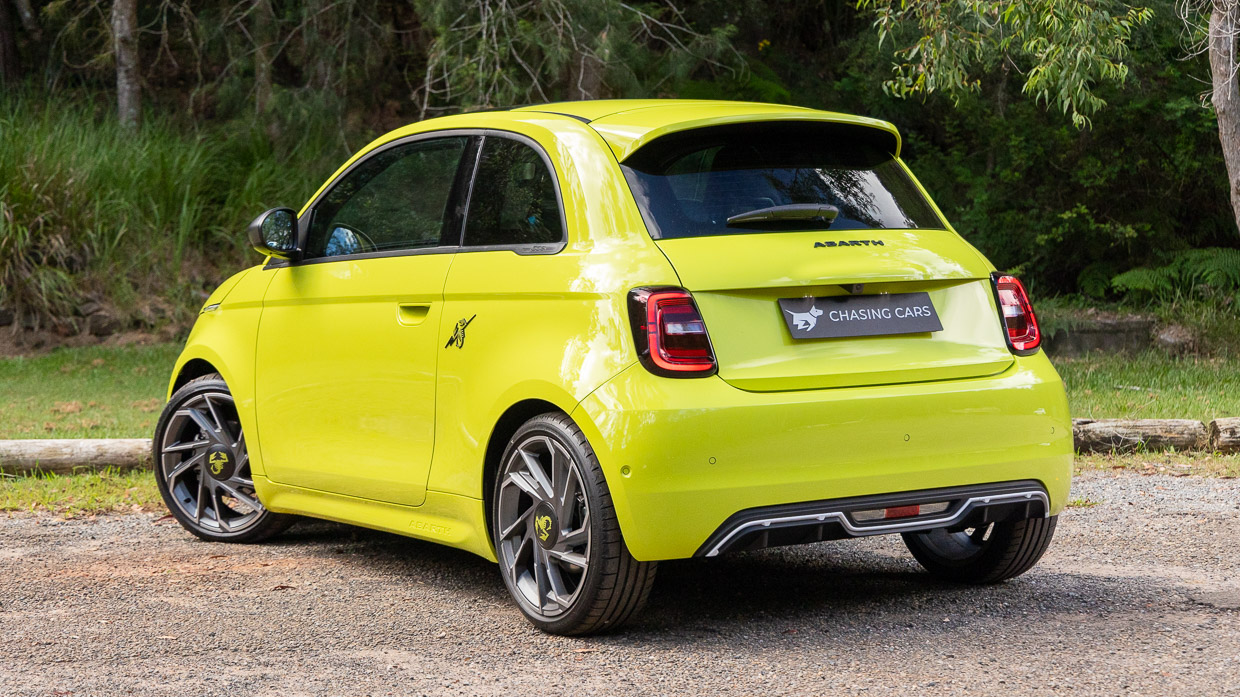
Which begs the question: why would you?
Well, nostalgia, for one reason. Few motoring nameplates, let alone current EVs, can match the heritage of feisty Italian – and the Fiat 500 it’s based off – and the very long route the Abarth 500e has taken to get here..
From the first Fiat 500 Topolino (1937) to the foundation of Abarth & C (1949), through the iconic 500 ‘Cinquecento’ (1957), Fiat’s acquisition of Abarth (1971), extinctions and rebirths (2004 Fiat 500, 2007 Abarth), and a new, new, new electric Fiat 500e (2020), it’s been a helluva ride spawning umpteenth Fiat- and Abarth-branded machinery.
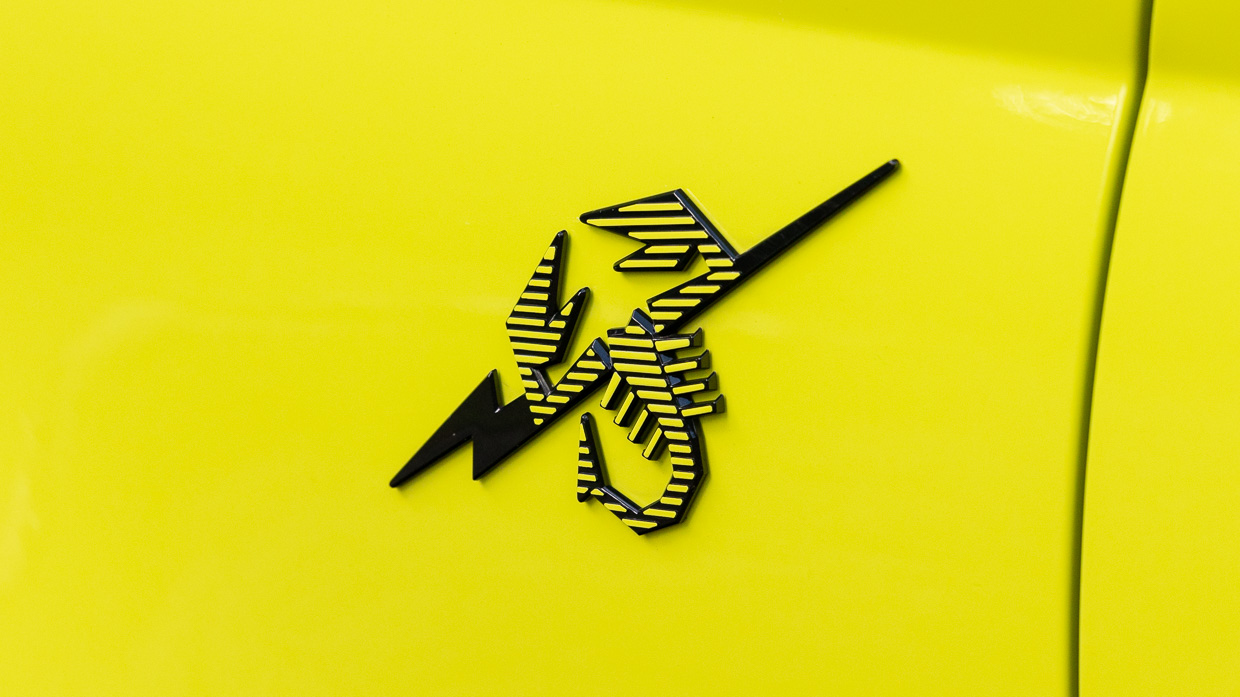
With the Abarth 500e’s arrival coinciding with the conclusion of production of all combustion 500-based models come mid-2024, there’s much riding on the newcomer’s shoulders as it spearheads the brand into a new era.
Unsurprisingly, it’s going to tap its legacy like a possessed carpenter while carving its inimitable niche into today’s fast-expanding EV landscape.
On-paper credentials? At “113.7kW”, or 113kW for grown-ups, and 235Nm, there’s not much shove. Fed to the front wheels via a single reduction drive, the seven-second 0-100km/h performance outcome is slow by most EV measures and is downright slovenly against the MG4 X-Power’s 3.6sec (as tested by Chasing Cars).
Its 42kWh (gross) battery, or 37.8kWh usable, and 400-volt architecture yields a best-case range claim of 253 kilometres, one of the shortest of any EV on sale, let alone one priced far beyond the high-$30K electric car entry threshold and on par with rivals touting around twice that range.
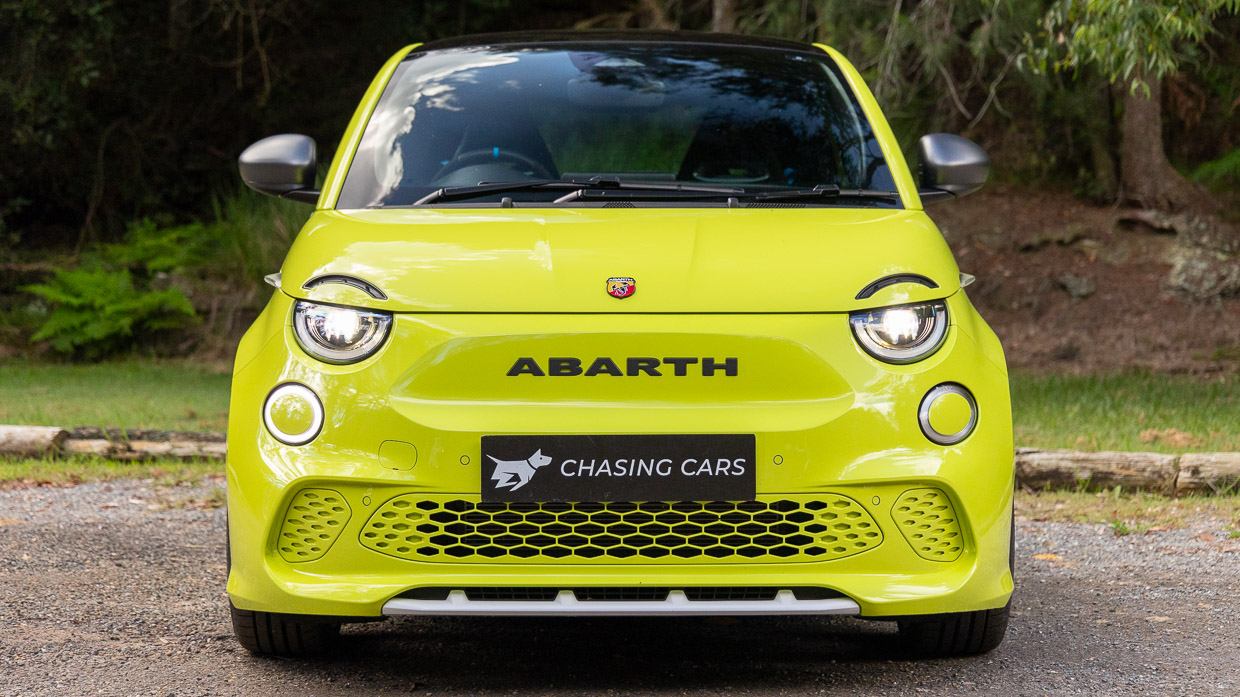
But this academia helps to serve a higher purpose: at 1335kg tare, or about 1410kg kerb, the Abarth 500e is supplanted by very few EVs – outside the regular Fiat 500e – for electric car lightness in weight.
Apply the Abarth go-faster ethos to those ingredients and it becomes patently clear that this particular newcomer lobs with the main aim of being the most fun you can possibly have powered by electrons for attainable money.
As we’ll discover, it’s a formula that comes with equal servings of pleasant surprises and notable shortcomings.
The Abarth 500e arrives in two variants in Australia: the regular Turismo at $58,900 list and the higher-spec Scorpionissima at $60,500.
The latter is essentially identical to the former, save for special ‘Abarth’ body side decals, standard Acid Green or Poison Blue paintwork and limited-edition status: just 1949 units will be built globally, a numeric homage to the year of Abarth & C’s formation.
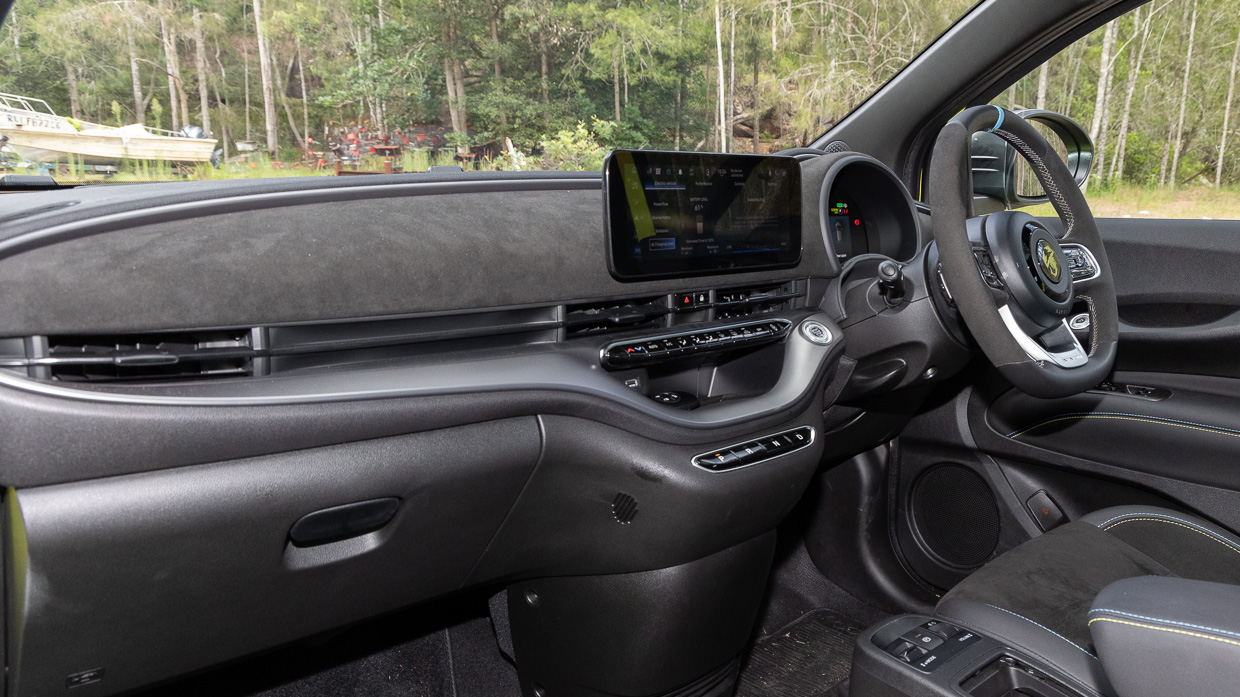
You can have your Turimso finished in either special green or blue paint options – out of a total of five colours – for a $990 upcharge.
Otherwise, identical standard features across the pair include:
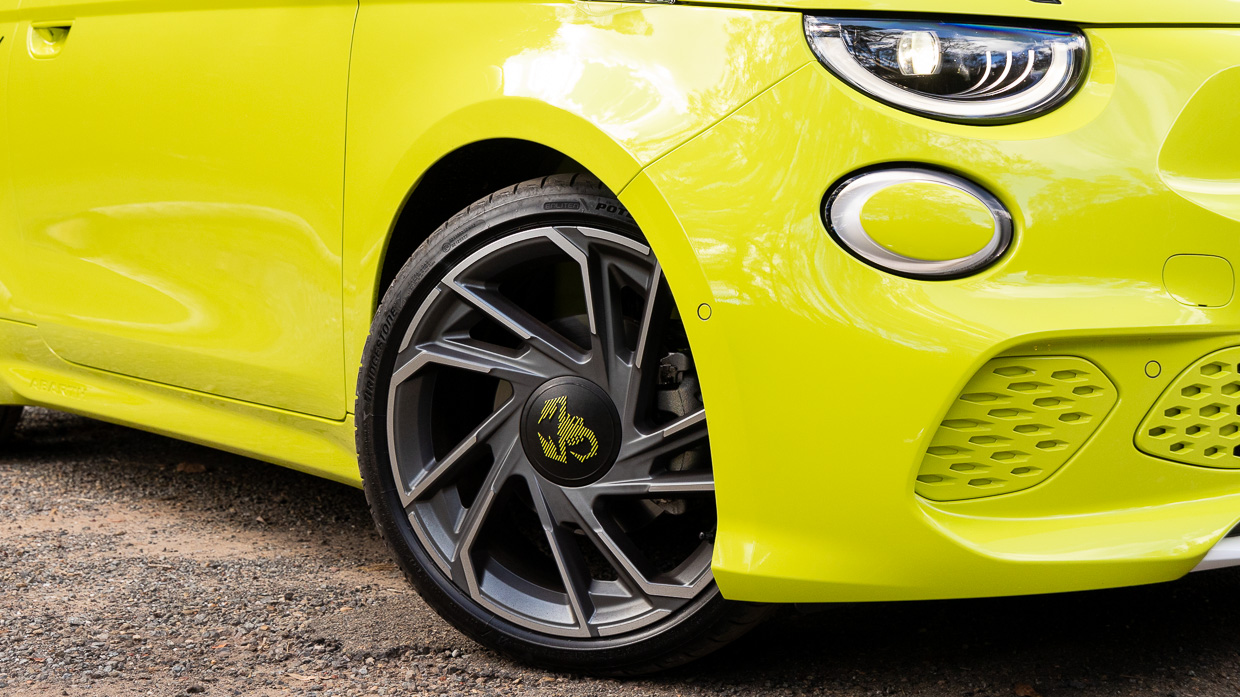
Worth noting is that the Australian-specified entry Turismo is offered in largely similar spec as a high-grade variant in the UK and Europe. Other markets offer a low-grade ‘regular’ 500e fitting cloth trim and smaller 17-inch wheels not currently sold locally.
Foreign markets also get a drop-top Cabrio version of the Abarth 500e – all Australian versions are glass/hardtop.
With myriad carmakers, bookend by the likes of MG and Porsche, widely favouring single-electric-motor rear-drive, did Fiat miss a trick in not rebooting the iconic nuovo 500’s rear-engine/drive format for today’s 500e? Given the largely (96 percent) clean sheet platform debuted in 2020, I’d thought so.
But what an absolute hoot the Abarth 500e is to drive, with gusto on a backroad, with the front-drive format it was developed on.
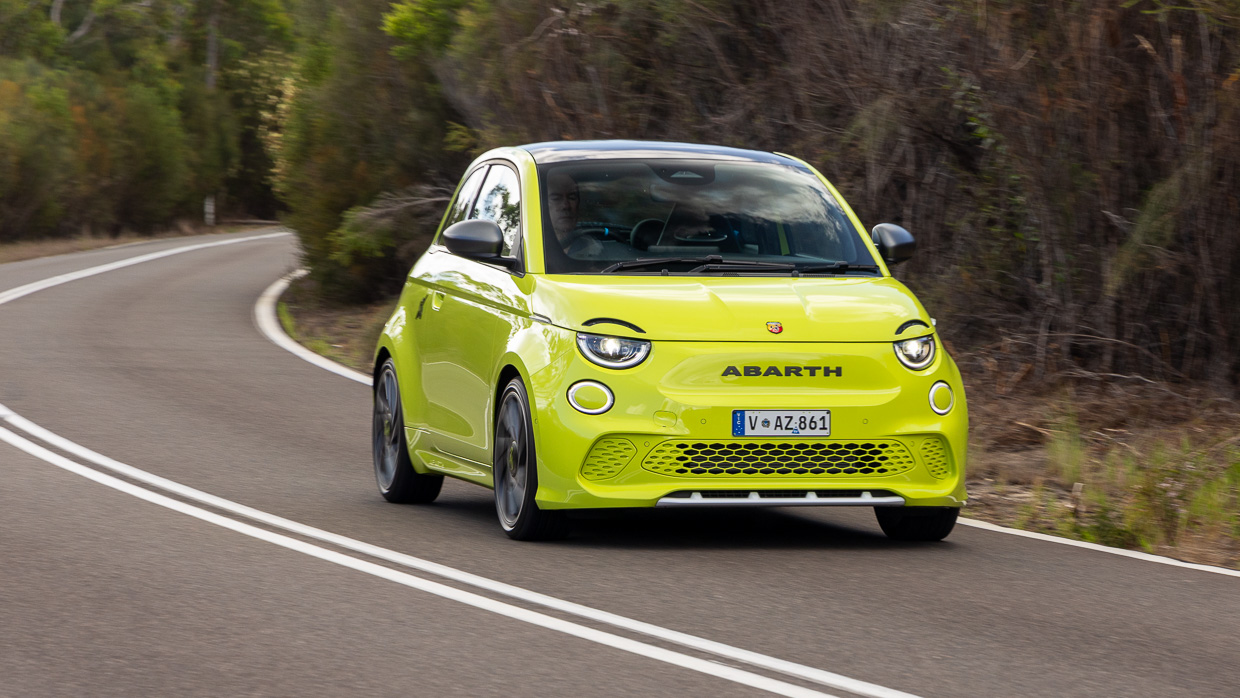
Of its three drive modes, Scorpion Street and Scorpion Track deploy full outputs, differing only in that the latter defeats heavy-regen one-pedal mode. And in either setting, the 500e feels much healthier and delivers with more urgency than the 113kW and 235Nm figures suggest.
Off-the-mark punch isn’t explosive, but the alert throttle, quick-surging torque thrust and impressive grip from the 205mm (Italian-made) Bridgestone Potenza Sports makes for heady progress, be it rolling on or firing out of the corner.
The 500e various highlights arrive thick and fast at a hot pace. Crucially, the steering is wonderful: meaty but not overly weighted, super-direct and precise, and even and linear in response. The nose is darty and very responsive, but to the detriment of accuracy and control.
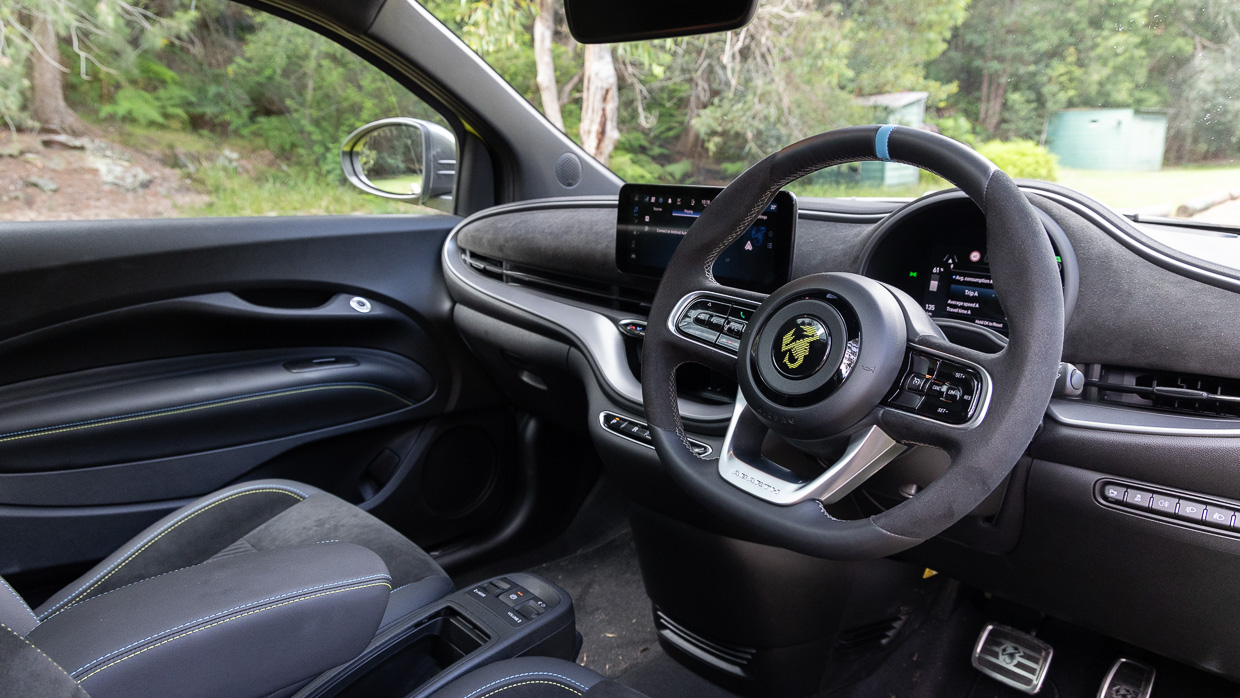
There’s no front mechanical limited-slip effect, though the blend of torque and traction rarely calls for it short of particularly ham-footed throttle enthusiasm exiting tight and lumpy hairpins.
The tail is quite planted and predictable, while the character during ‘lift-off’ varies greatly whether you’ve opted for strong (Scorpion Road) or mild (Scorpion Track) regen. By either way, changes in direction are crisp and lightning swift and the chassis’ mid-corner rotation is downright enthusiastic. It’s not taily, but it doesn’t need to be.
The new 500e’s track is a significant 60mm wider than the combustion Abarth while adding 24mm more wheelbase. Whatever academic enhancement this ought to bring to heightened dynamics, it’s certainly tangible in effect. And no doubt polished to an impressive degree by a few other factors.
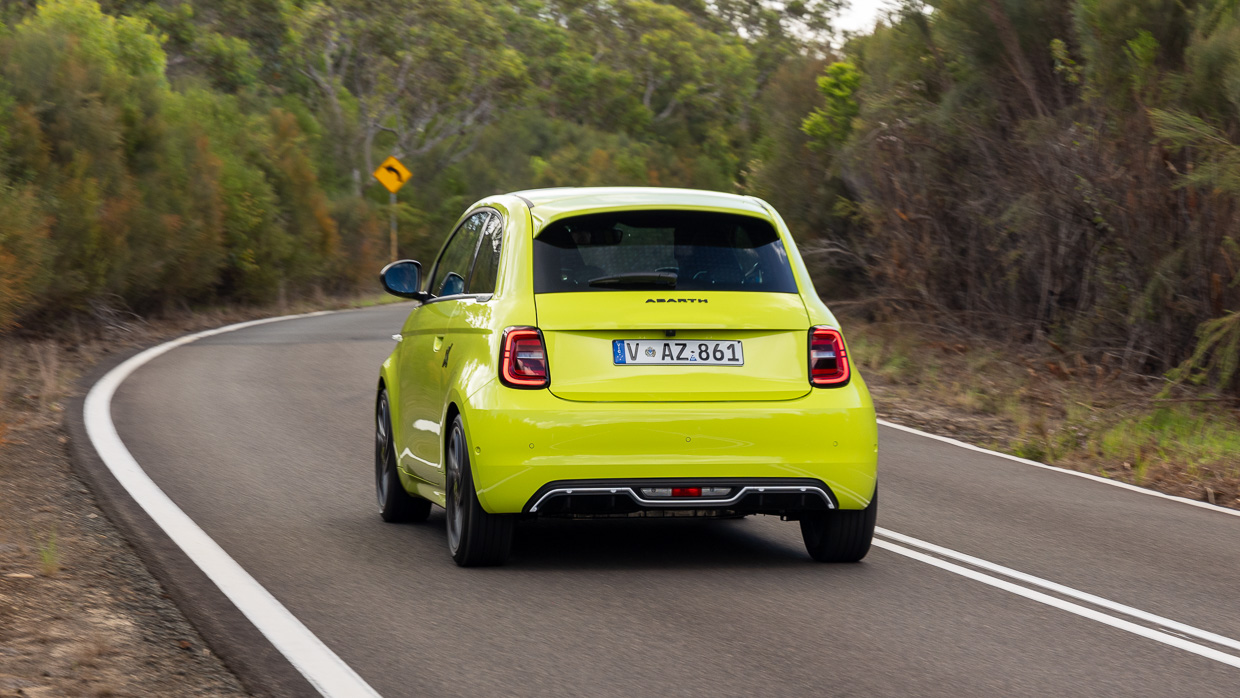
The suspension is excellent. Sure, it errs towards firm as a default, but it’s vastly more compliant and forgiving over bumps than older combustion Abarth pocket rockets.
At once, there’s a clean edge to the handling character, yet the pliable bump control maintains body composure and tyre traction that allows you to dig deep even across deep mid-corner dips and lumps.
There’s an alertness and agility to the 500e that few EVs come close to matching and really for one crucial reason. All of its go-fast virtues are underpinning by its light weight.
Nothing dull. Nothing ponderous. Just lithe engagement. And Abarth simply played into this by polished up the rest of the dynamic package extremely well.
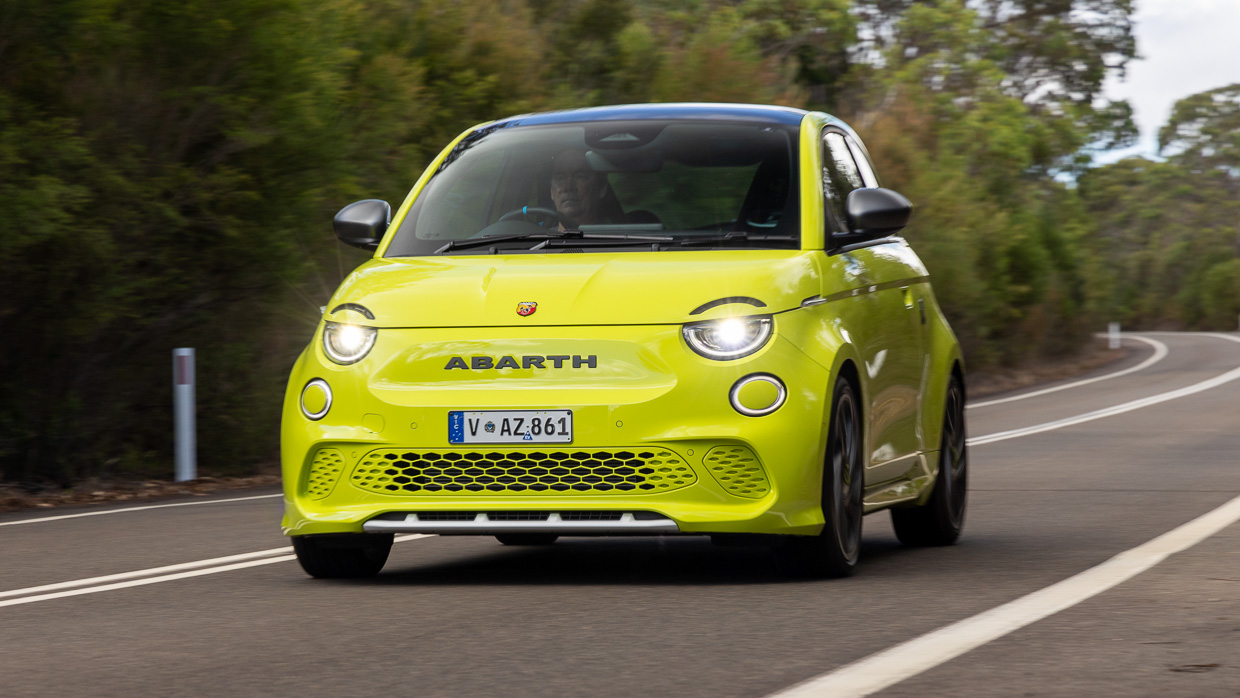
To some extent the sound generator, replicating a loud and raspy combustion engine’s four-outlet Record Monza exhaust note, is some added sensory earcandy.
It sounds beaut, if conspicuously synthetic, and it’s confoundingly activated via in dash submenus available only at standstill – just why there isn’t a quick, on-the-fly activation button is mystifying…
At least, it sounds good while the faux-rpm rises and falls while modulating speed through a succession of corners. However, at a constant speed, the note becomes monotonous drone, largely because, unlike an Hyundai Ioniq 5 N for instance, the 500e doesn’t fake gearchanges to vary the timbre.
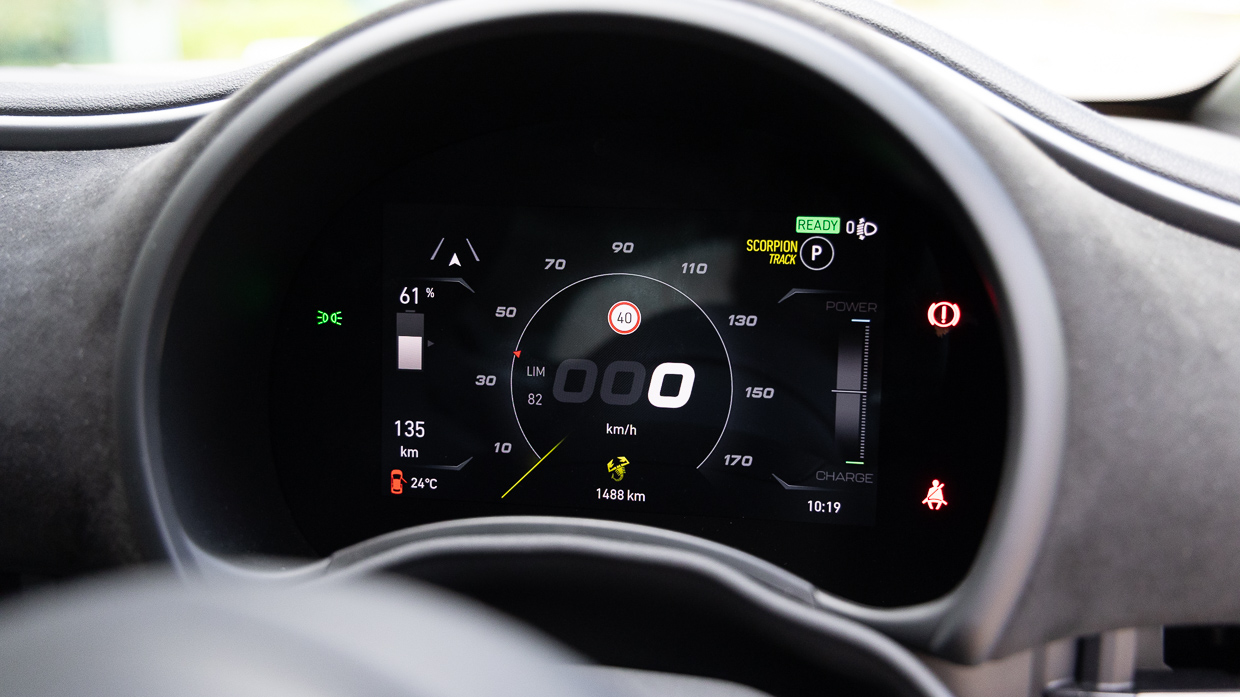
Nor might fake gears necessarily suit the Abarth 500e’s character. Fake gearchanges mean paddleshifters, which means added complexity for a device that is really, at its core, uncomplicated.
Instead, the underpinning vibe is one of an oversized electric go-kart, such is the simplicity and purity of its engagement with the driver and with the road.
Dial it back and the Abarth 500e does what so many petrol forebears fail to do: transform into a comfortable, easy to live with urban runabout.
Switching to the mildest Turismo drive mode dulls the throttle and scales back outputs to 100kW and 200Nm while maintaining strong one-pedal regen.
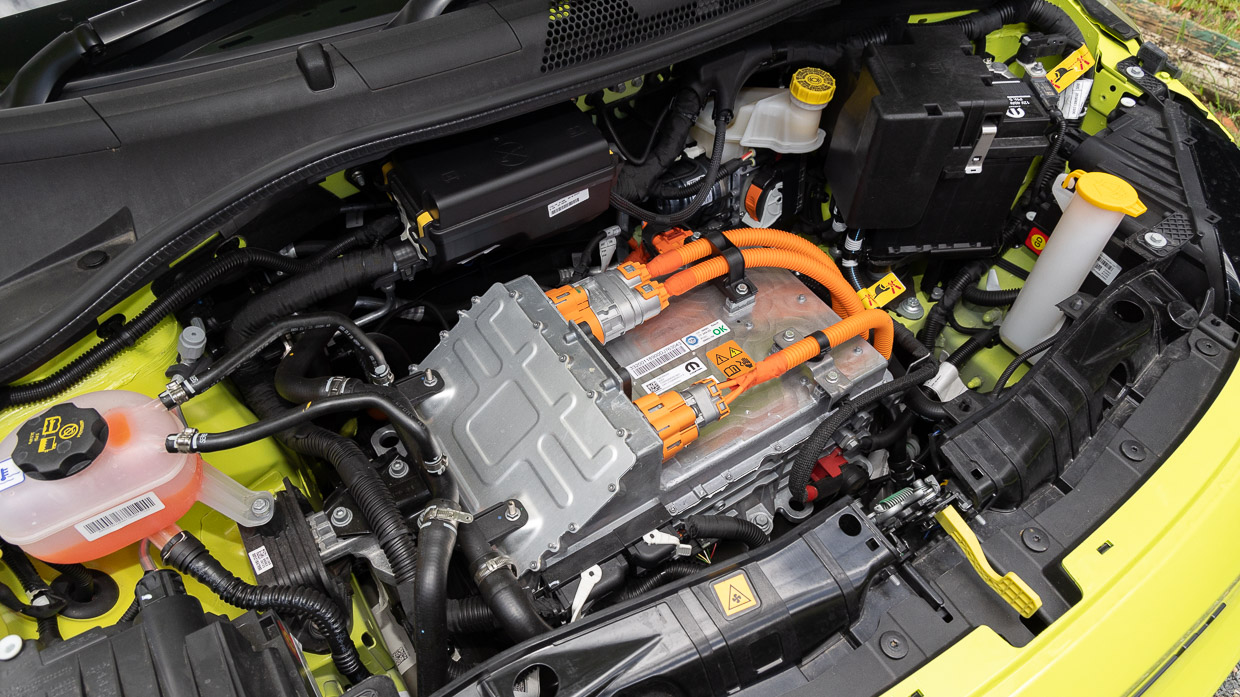
Given the instant electric torque is maintained, this mode doesn’t feel caught short for shove, but rounds off response that’s easier to live with in stop start traffic so that the car doesn’t constantly lunge forward.
The regen itself is paired to the drive mode and it isn’t switchable or adjustable – another missed trick – though the three modes are well suited to the environments and driving they’re tuned for. That said, I do find myself opting for Scorpion Track for highway use, as the low-regen effect is more relaxing on the right foot during long stints.
Even around the inner city, the 500e remains a hoot: it’s petite size, fantastic outward visibility and instant rolling thrust makes poking holes in traffic on any whim downright fun.
And yet its behavior changes in direct relation to driver inputs, the 500e transforming to a silent and comfy peak hours commuter without so much as touching a button.
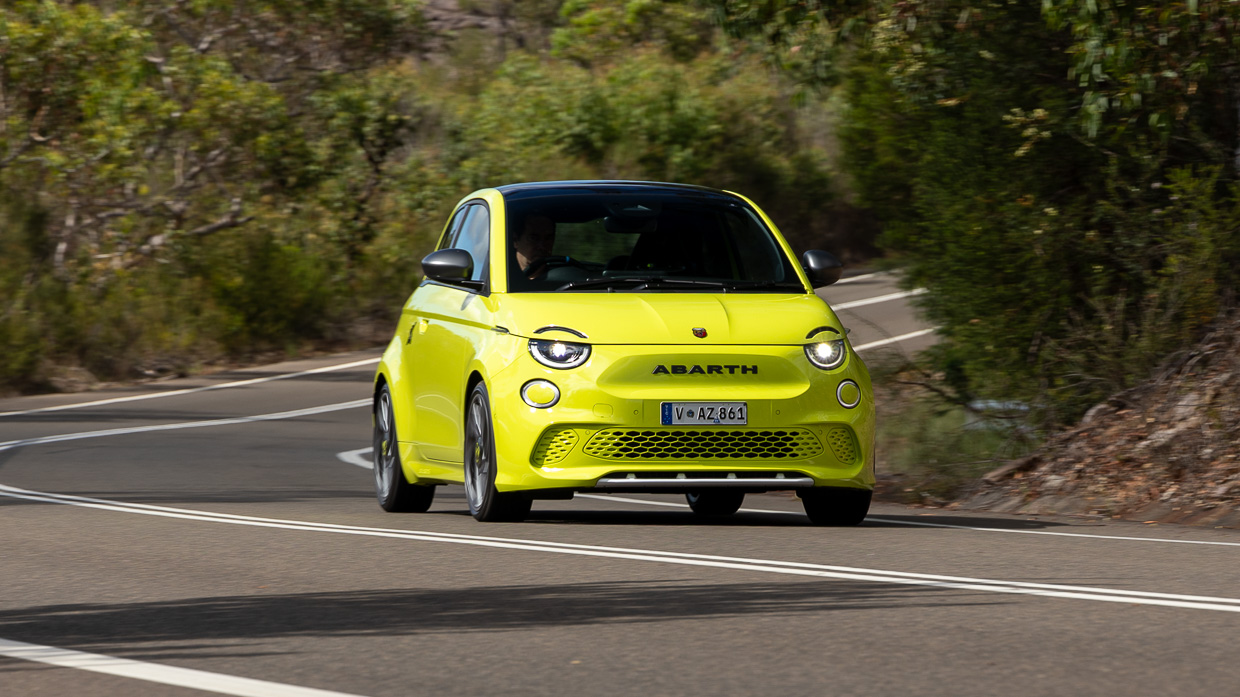
If there’s a major shortcoming, it’s the driver’s footwell.
Clear evidence suggests that the central stack between the front passengers’ footwells was intended to favour left-hand drive, leaving less than enough space between the console trim and brake pedal for your average size-10 sneaker.
It’s a glaring oversight and impacts the driver’s left leg comfort and, hopefully, an easy rolling fix.
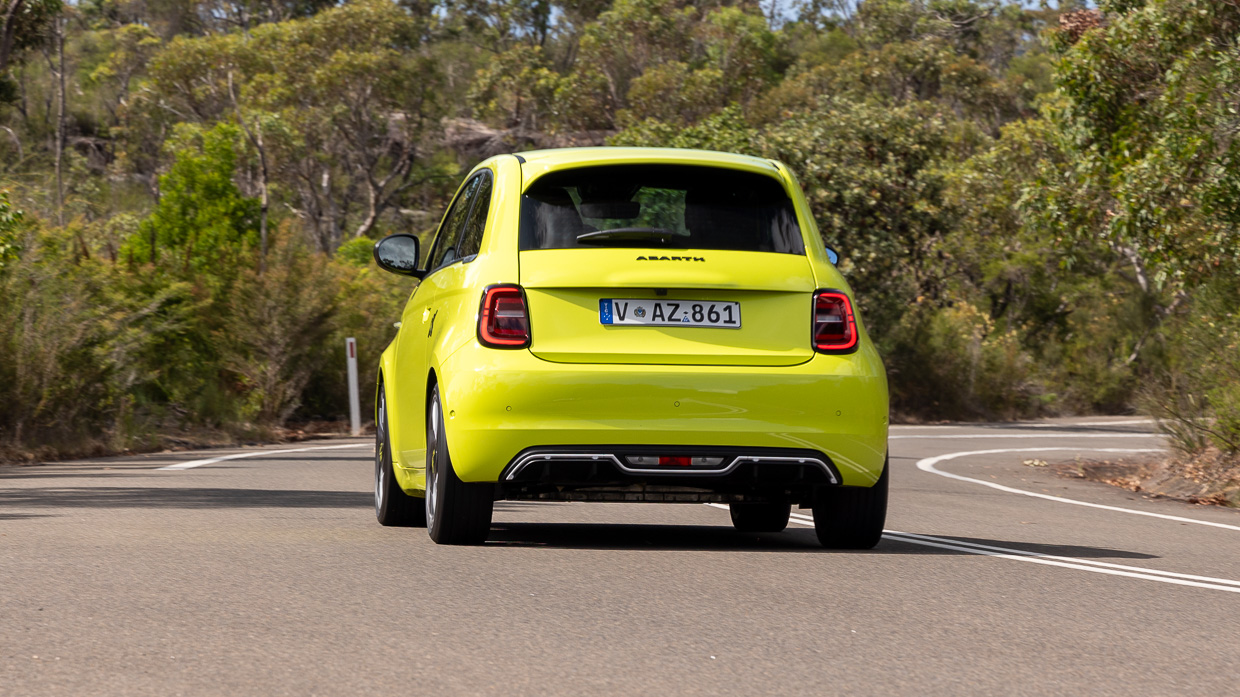
Another gripe is the strange low-speed braking effect. Coming to standstill, the car almost jolts to a stop in an effect that feels no unlike a half-cocked handbrake or overly eager automated parking brake.
It’s only a slight annoyance, if one where much submenu digging can’t unearth any fix for.
Otherwise, its start-and-go simplicity makes it easy to enjoy its various on-road virtues, and thankfully there’s little active safety or ‘assistance’ annoyance on the move. It’s just a real shame that whatever fun factor it brings gets dampened all too often by range anxiety, which we’ll get into further below.
New-school electric door latches grant access to a cabin that lays on both racy and retro vibes thick and is minted in a very dark grey theme boasting subtle lime green and blue highlights.
Yes, it’s compact real estate, though the packaging itself is, like the last generation, quite efficient. Adjusted with no sympathy for rear passenger space, the 500e can feel downright airy, thanks largely to the longer seat adjustment, the high glass roof and huge side windows that offer fantastic outward visibility.
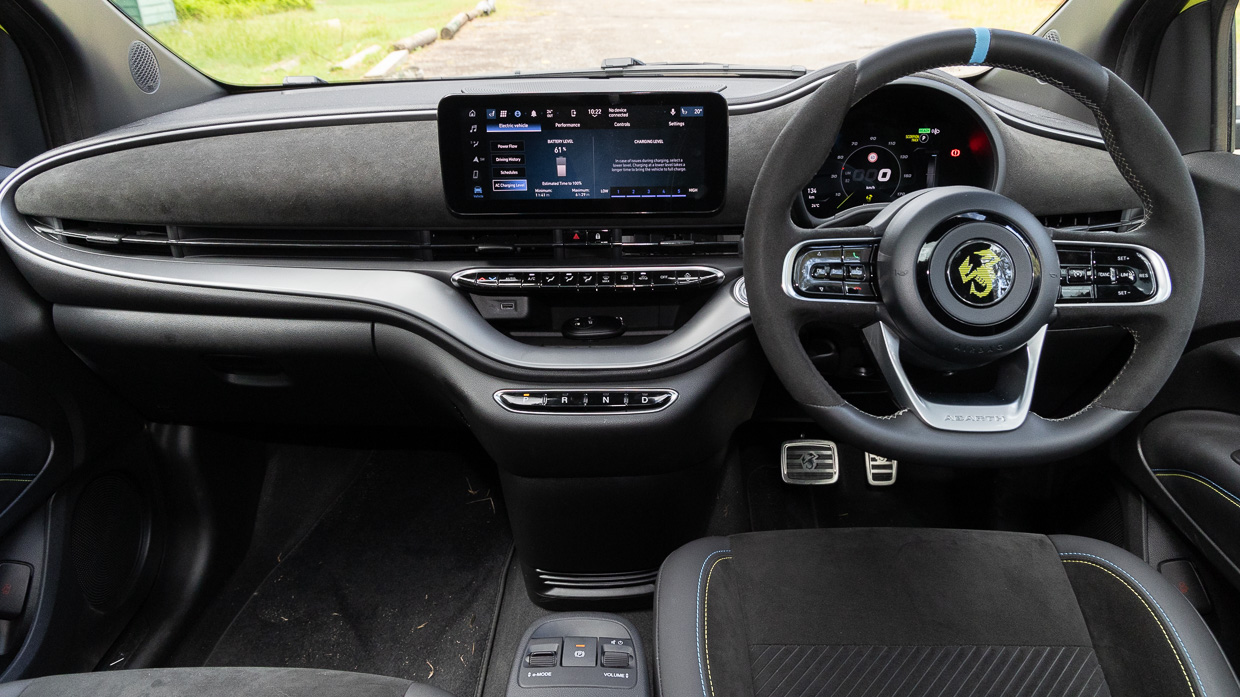
Turismo spec also trowels on the Alcantara across the seats, the wheel and the dash fascia, a love it (as your reviewer does) or loathe it material if perfectly in-step with the 500e’s go-fast aspirations. Less cohesive, though, is the faux suede contrast with the cheap, shiny door cars moulded from what resembles ballistic-grade plastic.
Older Abarths did suffer some ergonomic challenges, particularly the outcome of a slightly hunched posture for the driver, a situation that seems to be massaged out of the newcomer. The driving position and driver comfort seems more natural than ever, save for the aforementioned, woeful driver’s footwell.
While the seats appear highly contoured, the flat seatback makes for less lateral support than you might expect, and underthigh support could be better. They’re heated but not cooled and are mechanically adjustable – no big markdown given the racy vibes.
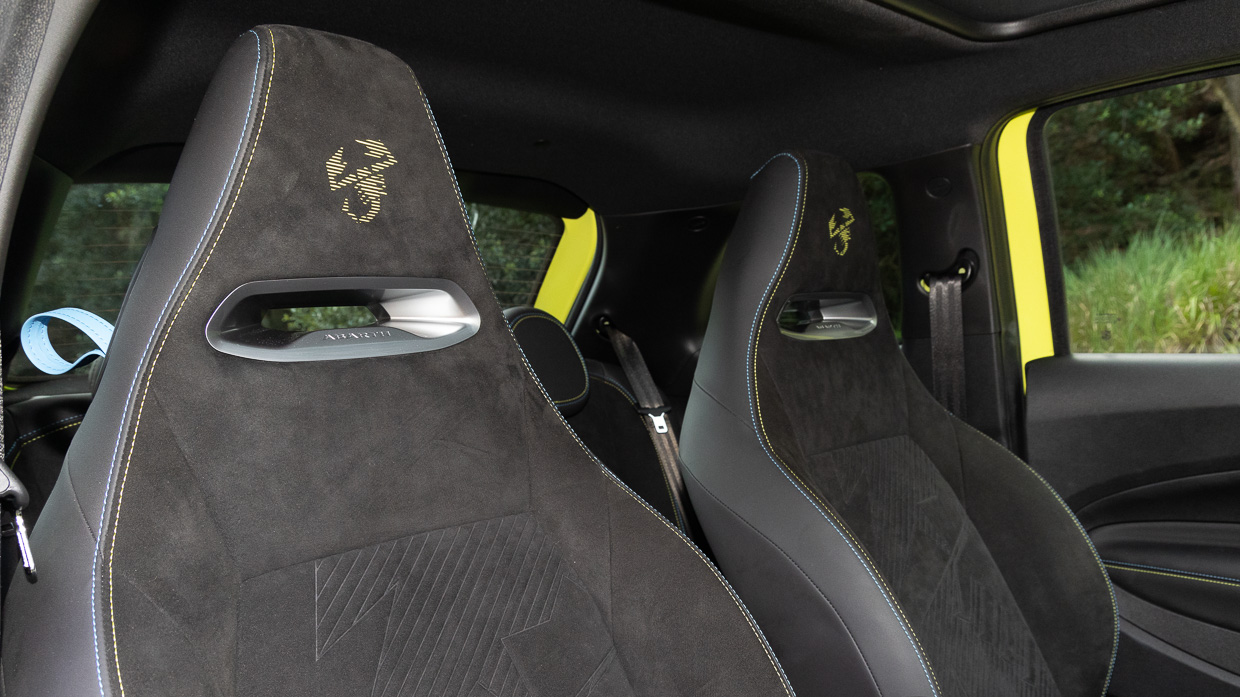
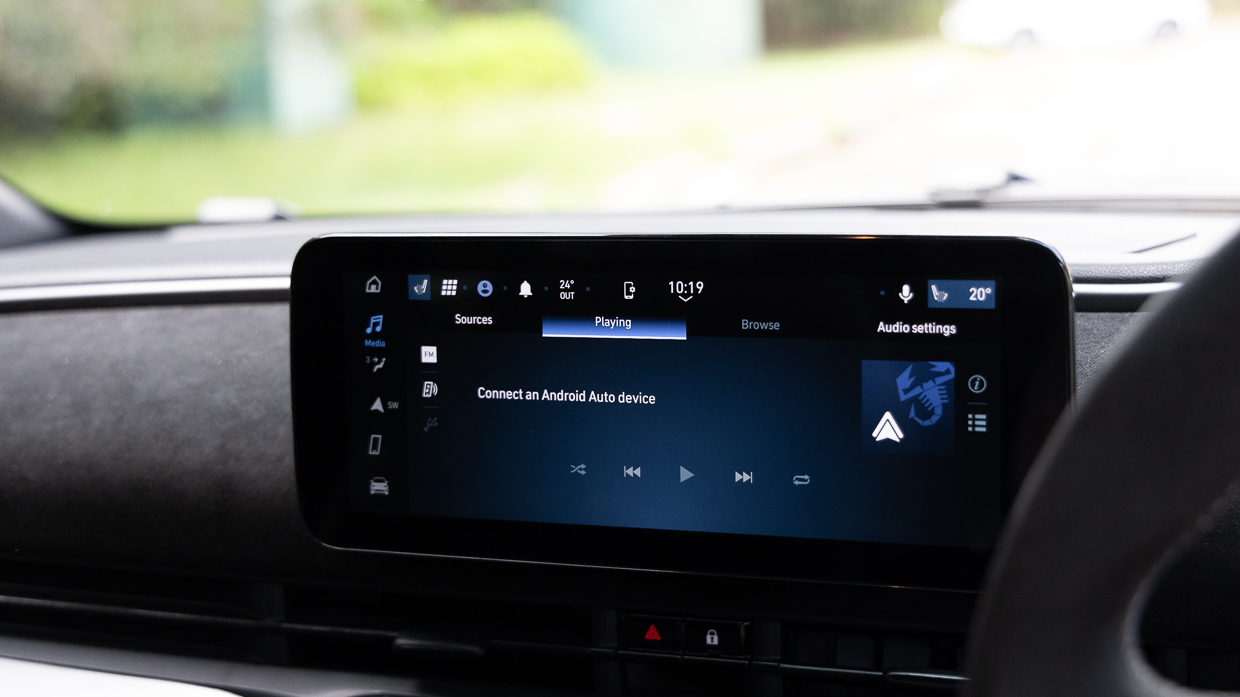
The wheel is lovely, grippy and pleasing in the hand while offering unfettered viewing of the sharp, configurable 7.0-inch TFT driver’s screen. Its three-spoke design – Fiat 500 gets two spokes – is apparently inspired by old-school rally tillers…perhaps, if you squint hard enough.
Multimedia is a mixed bag. It’s a 10.25-inch system that includes wireless Apple CarPlay and Android Auto, as well as proprietary satnav, a reversing camera of reasonable quality, and requisite ‘pages’ for electro and performance driving telemetry.
However, the Uconnect format is slow at times, unresponsive to touch input at others, and phone mirroring is prone to occasional drop-out and belligerent reconnection.
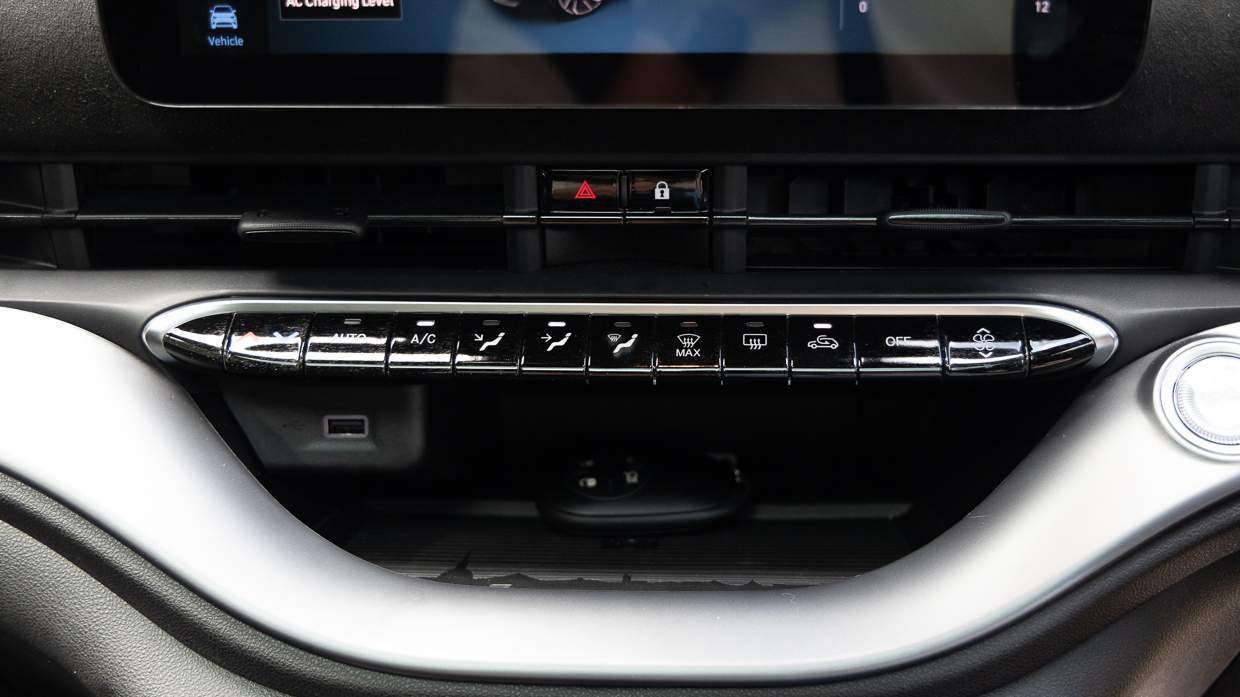
Thankfully, Abarth (and Fiat) have arrived at a general control layout that’s minimalist yet caters for physical controls and button for most of the features you want to access easily.
So you get dedicated HVAC control, drive control buttons, audio volume and drive mode select all within fast and convenient reach. The ‘map of Turin’ inductive phone pad motif is also a neat little Easter egg.
Storage space, though, is a premium. The tiny rabbit hole of a console bin is meant for keys, wallets, device power (USB-A, USB-C and 12V outlets) and the sole cupholder buried deep below, requiring very awkward access.
I found myself throwing most personal belongings onto the passenger seat for most trips. It’s perhaps the nature of a tiny beast…
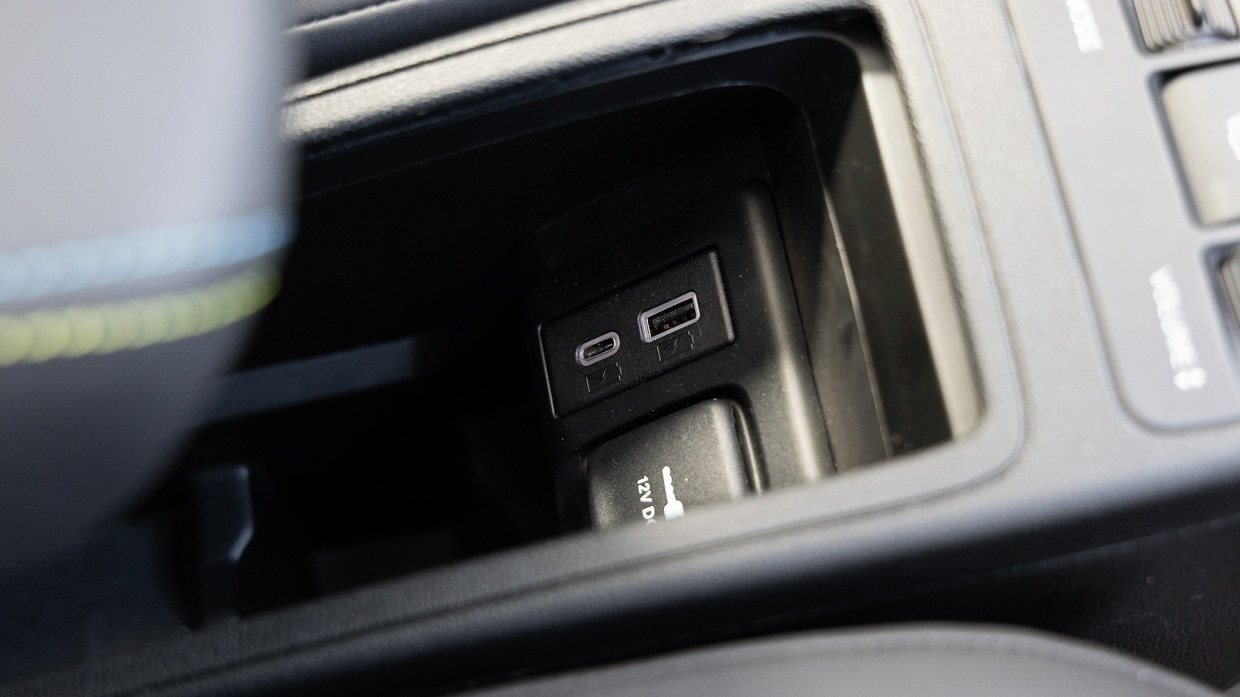
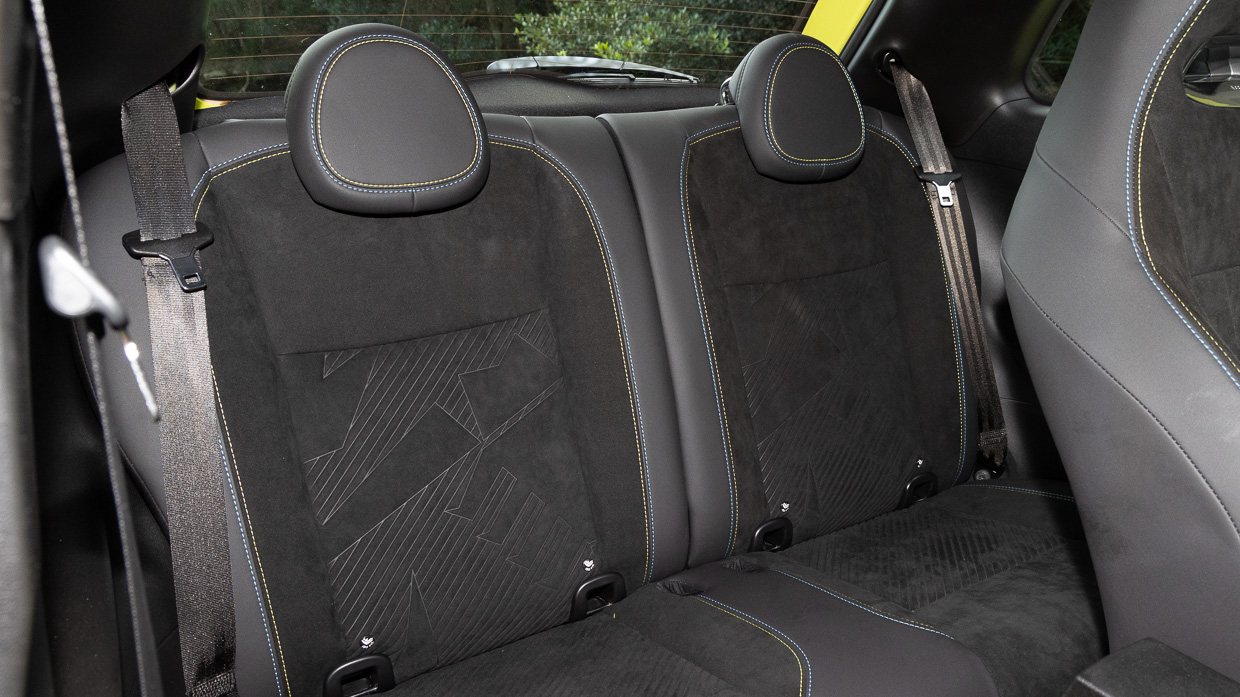
Avoidable, though, is the cabin heat sink brought about by the retractable translucent mesh scrim used for the glass roof. Even during moderately warm days, sunlight penetrates into the cabin. Given there’s no metal lid option, your reviewer would be solid wrapping the roof in ownership to keep out unwanted heat and light.
Row two… Look, there’s no realistic solution to the inconvenient byproduct of a car that celebrates its compactness wholeheartedly. You’re either going to treat the 500e as a two-seater, or prepare thyself for the alternative occupational misery.
Even with the front seats jammed forward, the best you can hope for is extreme four-occupant discomfort.
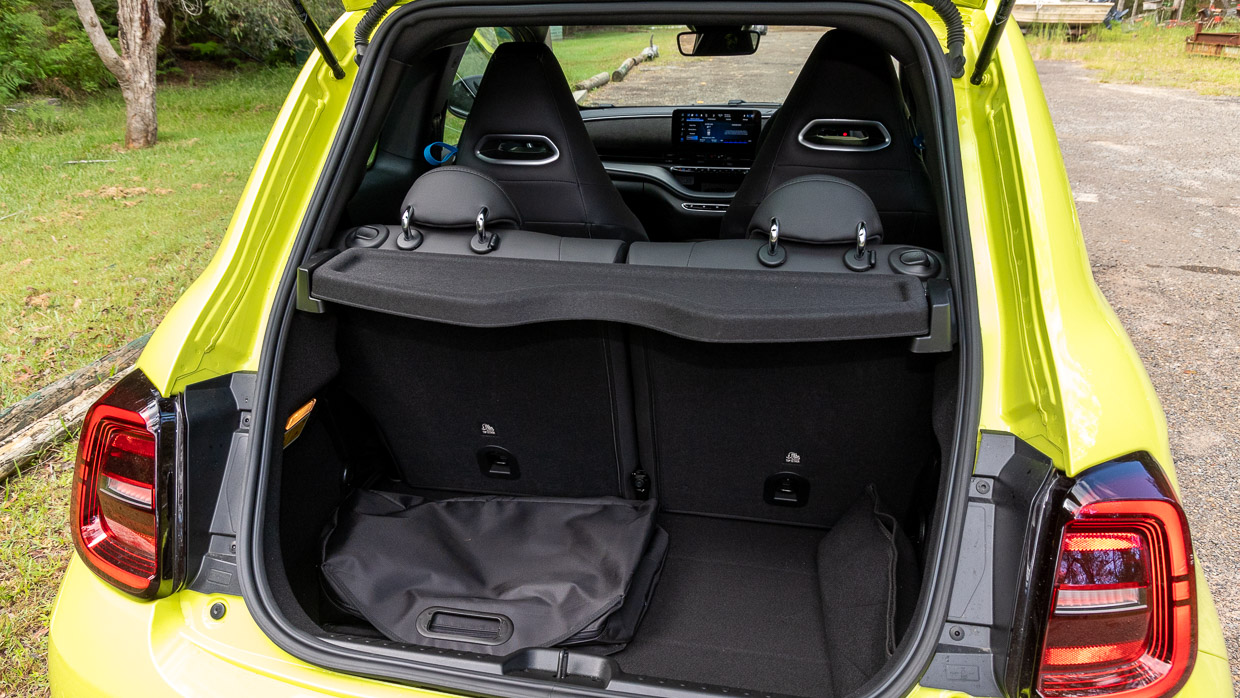
But treated as a two-seater, the advertised 185L of bootspace – minus the volume taken up by the mode 3 cable and tyre inflator kit baggies – expands quite nicely with the rear folded forward (albeit to a slant rather than flat).
You can actually fit a couple of travel cases or a lot of groceries if you choose to ignore the existence of the second seating row…
While the Abarth 500e is currently unrated by ANCAP, the related Fiat 500e scored four of five stars in an assessment conducted back in 2021 applicable to Fiat variants.
It scored 78 and 79 percent respectively for adult and child occupant protection, 67 percent for vulnerable road user protection and 67 percent for safety assist.
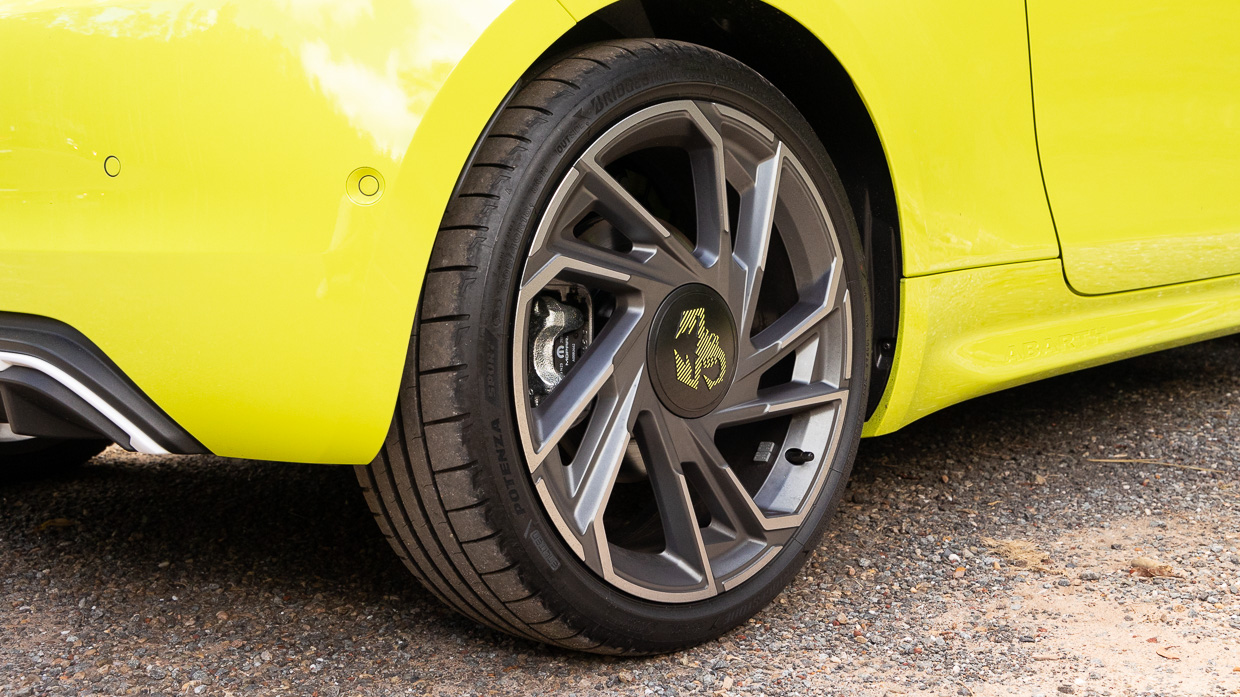
As standard, the Abarth 500e fits:
The Abarth also features four-wheel-disc brakes, whereas the related Fiat 500e variants fit rear drums.
The 400-volt 500e fits a modest 37.8kWh usable (42kWh gross) lithium-ion battery with less-than-rapid 85kW DC and 11kW AC charging rate peaks.
During our week with our Acid Green example, consumption generally hovered between mid-16 and low-17kWh/100kms indicated, using a mix of drive modes. Our best-cast economy run, in mild Turismo mode, retired 15kWh/100km, or bang on Abarth’s 14.9kWh claim.
But the really major consideration – a multilayered consideration – in ownership is the claimed range of 253kms WLTP, one of the shortest in the biz. And in our own testing, again, it was bang on its claim (252km as assessed).
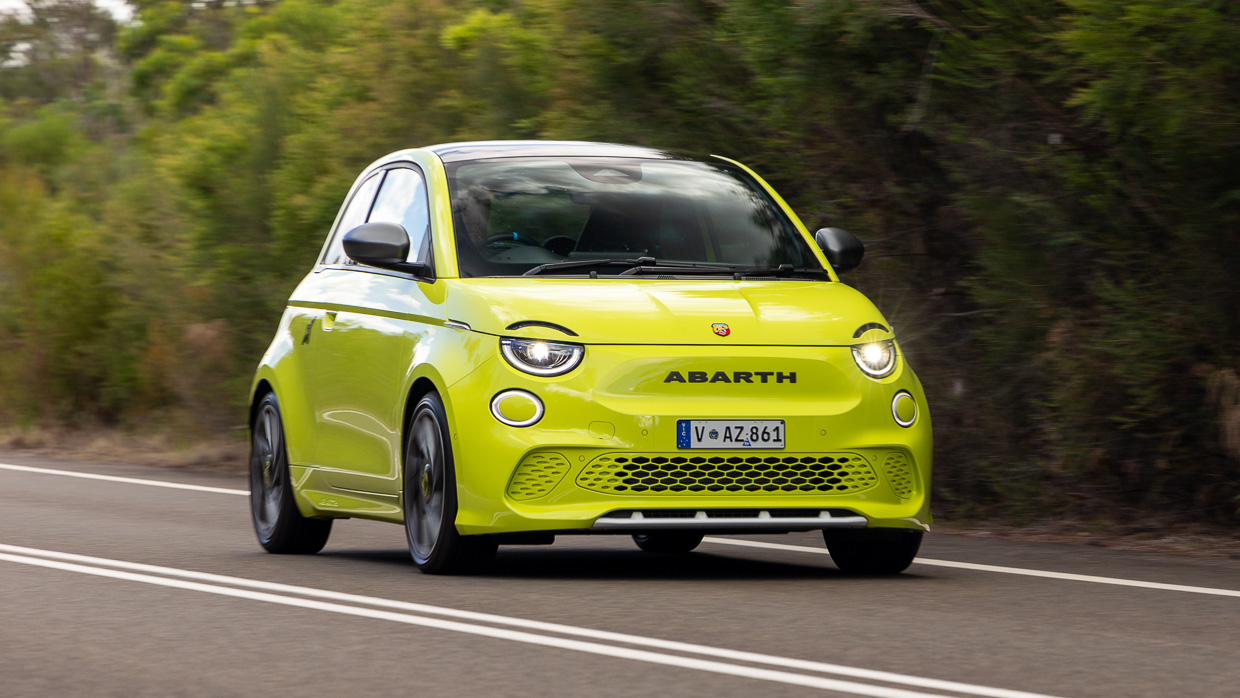
In comparison, the Fiat 500e’s claim is 311km, while we’ve seen circa-450km from Tesla Model 3 RWD and around 400kms for the MG4 X-Power in private testing. Further, the Abarth’s $60K price pitches it against many EV capable of double of its range.
The main issue is if you plan to primarily use public DC fast charging. Stellantis quotes 35 minutes for a 0-80 percent charge. Fine. The reality is that you’ll never get it anywhere near zero charge because of the natural range anxiety of such a fast-depleting battery.
Here’s why. A 20-percent charge in a 500km-capable EV affords 100km of headroom. This allows the convenience to choose where and when to charge, to counter issues of busy stations or disfunctional infrastructure, or to defer charging for a later time. Meanwhile, 20 percent in the Abarth – 50km available range – requires commitment to recharge imminently, come what may.
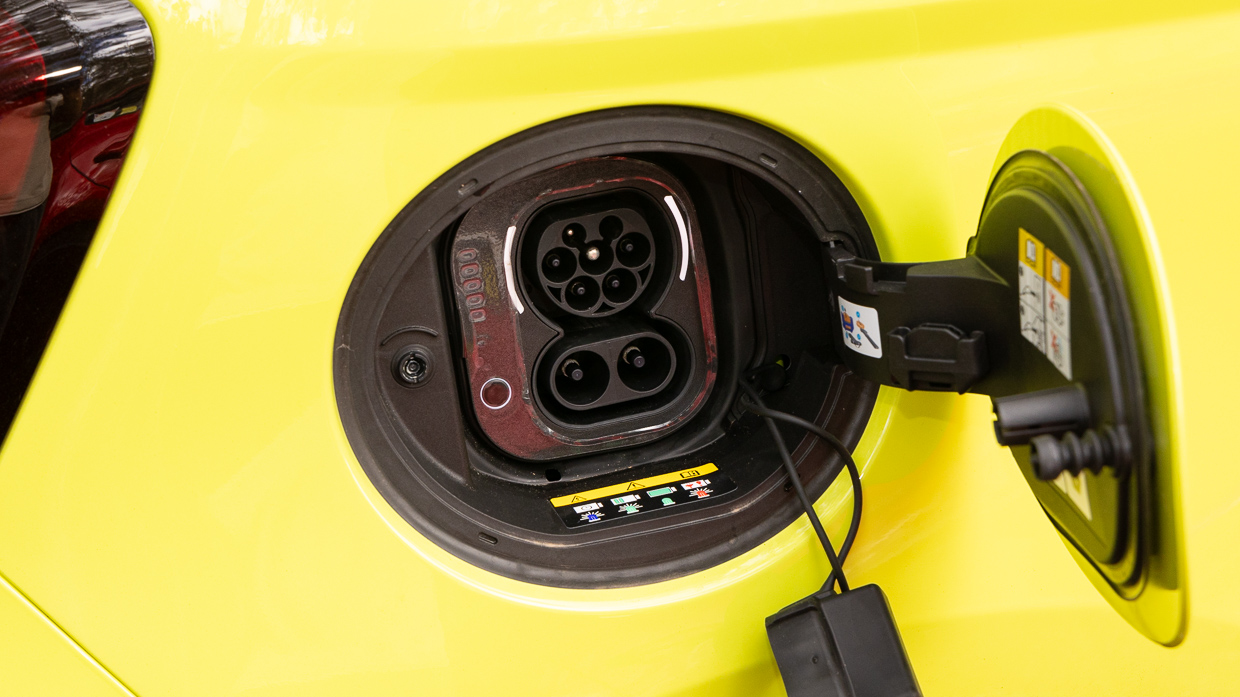
Fact is, you’ll spend a significantly larger percentage of time between charges considering your next public charging option…rather than enjoying the virtues of the vehicle.
Then there’s the drop-off charging speed north of 80 percent using DC. While a 20-80 percent charge takes around 25mins – an added 150km-odd dividend – a further 80-100 charge requires an additional hour on the hose. An extra 60 minutes for adding just 50km of extra range is, frankly, a hugely diminished return.
Result? Prudence and the pursuit of sanity lead your reviewer to target 20-80 percent DC charging strategy as the norm of, obviously, 150kms public station to station.
Our advice is this: consider a proprietary AC wall an essential companion for the Abarth 500e. At its 11kW AC peak, a 0-100-percent charge is around 4hrs 15min.
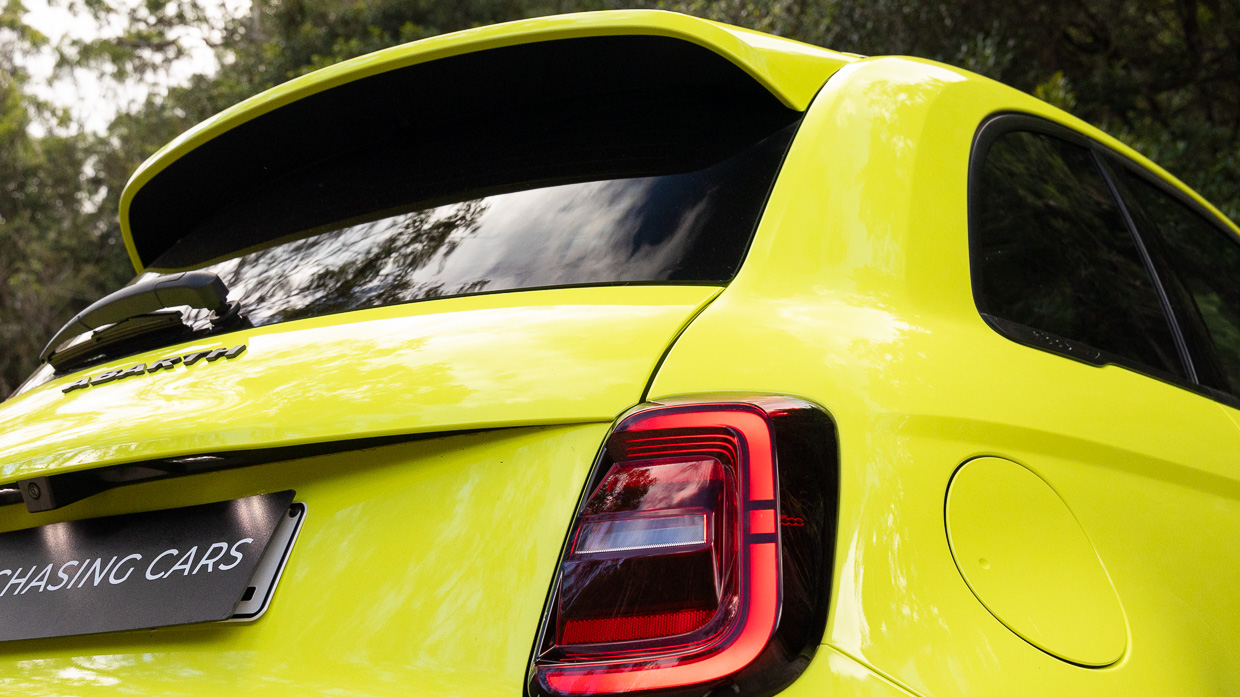
Plug in religiously at home overnight, or at work during the day, and you’re suddenly looking at a vastly more practicable proposition…if you avoid those long road trips.
Elsewhere in ownership, the warranty is a very slim three years capped at 150,000kms. Far from ideal.
Servicing, though, is more acceptable, with typical 12-month and 15,000km intervals capped at $300 per visit, or $1500 over five years.
Confession time: your reviewer is quite smitten by the Abarth 500e.
It’s a barrel of fun around town, an absolute hoot on a backroad, and is surprisingly comfy and easy to live with as a commuter. And it’s as quick as it needs to be in all situations.
The Abarth 500e is also incredibly charming, and its retro spin and throwback format is an ideal antidote to the groundswell of techno-fetish EV alternatives.
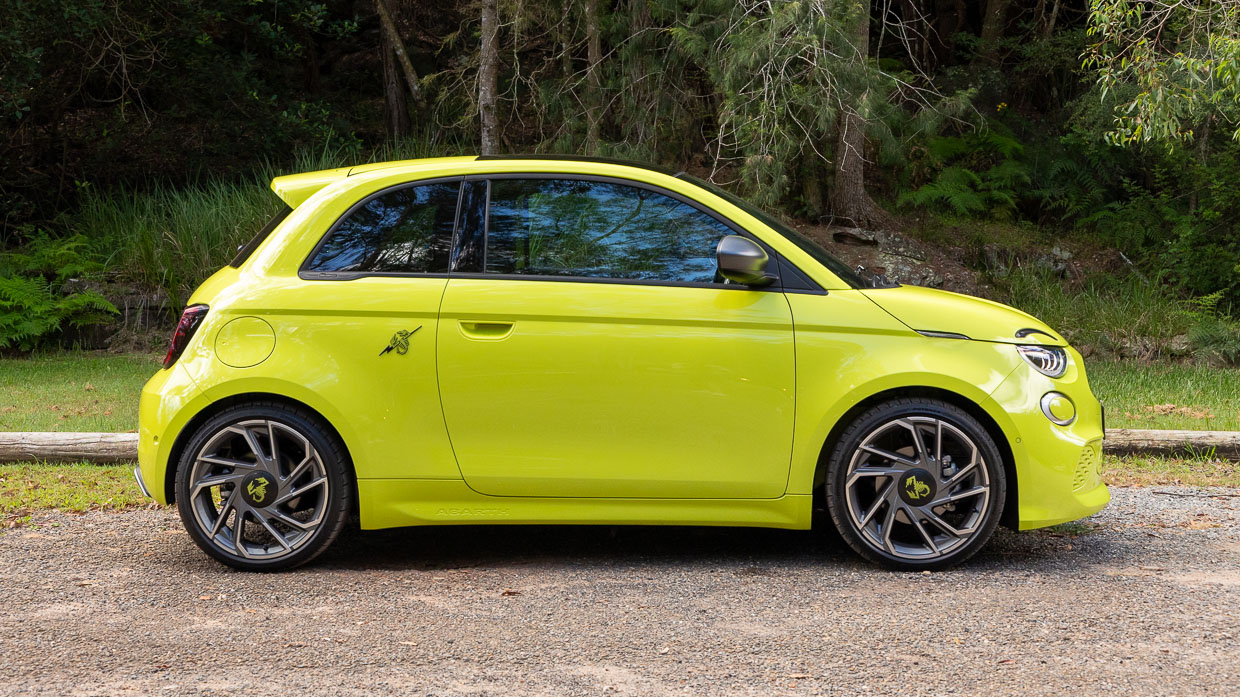
Size and practicality? It’s best treated as a two-seater with an expandable boot space, but it’s totally workable and usable for certain lifestyles in certain environments. Its pint size isn’t for everyone, but almost 90 years of ‘500’ providence is ample proof of concept.
It’s also yet another example that the EV world is graduating from its arms race of escalating power, weight and excess into an era of more relatively modest EVs for more modest buyer means and budgets.
If you want proof that electric drive in a lightweight vehicle is a cracking combination, it’s right here.
And yet, the Abarth 500e is about $10K too pricey. So while there’s a fair argument that $60K rarely offers this much EV fun factor, it’s simply too much outlay, in 2024, for its relatively rudimentary high-voltage credentials. And, besides, the slightly-quicker, more-powerful petrol Abarth 695 lists (while the going is still good) for under $40K.
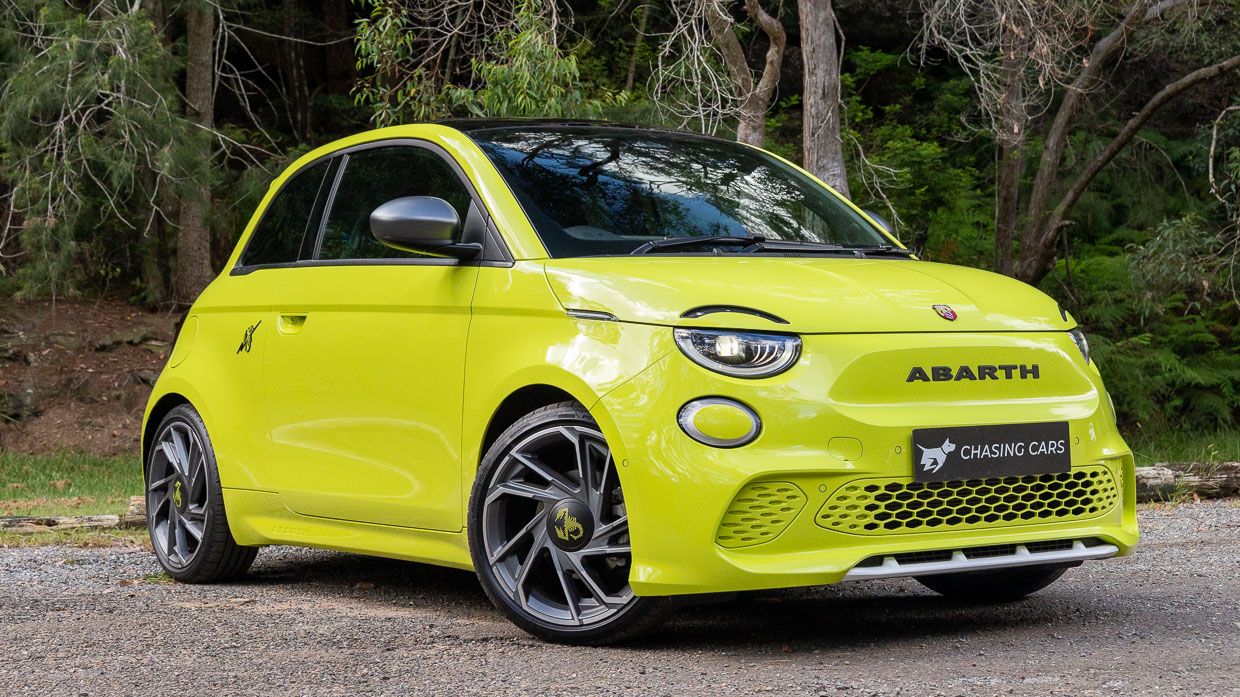
It also suffers some clumsy execution: the footwell oversight, the glass roof scrim, having to dig through submenus to activate the sound generator. All of these, hopefully, will be amended as rolling changes or in a key model update.
But the real anchoring point is the paltry range. The sheer inconvenience really robs from the model’s many virtues day to day.
It needs a higher density battery: same size, same weight, if with a range capacity starting with a four. If such battery tech is in the pipeline, as it most likely is, then it’s possible that the fix to Abarth 500e’s biggest shortcoming might be a facelift away.
Key specs (as tested)
About Chasing cars
Chasing Cars reviews are 100% independent.
Because we are powered by Budget Direct Insurance, we don’t receive advertising or sales revenue from car manufacturers.
We’re truly independent – giving you Australia’s best car reviews.
The estimate provided does not take into account your personal circumstances but is intended to give a general indication of the cost of insurance, in order to obtain a complete quote, please visit www.budgetdirect.com.au. Estimate includes 15%^ online discount.
^Conditions Apply
Budget Direct Insurance arranged by Auto & General Services Pty Ltd ACN 003 617 909(AGS) AFSL 241 411, for and on behalf of the insurer, Auto & General Insurance Company Limited(ABN 42 111 586 353, AFSL 285 571).Because we don’t know your financial needs, we can’t advise you if this insurance will suit you. You should consider your needs and the Product Disclosure Statement before making a decision to buy insurance. Terms and conditions apply.
Indicative quote based on assumptions including postcode , 40 year old male with no offences, licence suspensions or claims in the last 5 years, a NCD Rating 1 and no younger drivers listed. White car, driven up to 10,000kms a year, unfinanced, with no modifications, factory options and/or non-standard accessories, private use only and garaged at night.
^Online Discounts Terms & Conditions
1. Discounts apply to the premium paid for a new Budget Direct Gold Comprehensive Car Insurance, Third Party Property Only or Third Party Property, Fire & Theft Insurance policy initiated online on or after 29 March 2017. Discounts do not apply to optional Roadside Assistance.
2. Discounts do not apply to any renewal offer of insurance.
3. Discounts only apply to the insurance portion of the premium. Discounts are applied before government charges, taxes, levies and fees, including instalment processing fees (as applicable). The full extent of discounts may therefore be impacted.
4. We reserve the right to change the offer without notice.